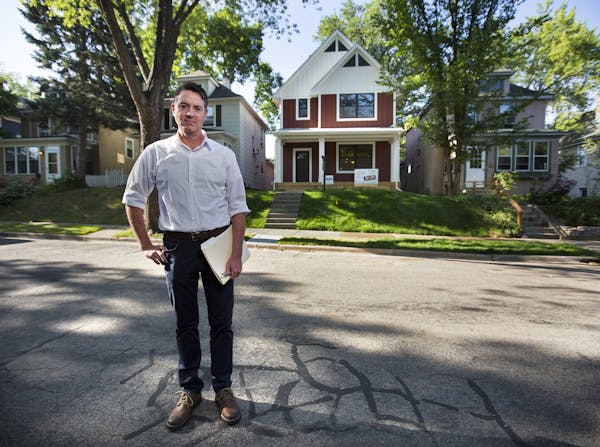North Minneapolis residents still reeling from the Great Recession offered a surprising reaction when developers unveiled plans to build homes that would sell for up to $300,000.
They won't sell, members of a neighborhood board said. There's no one in the area with that kind of income. The houses will sit empty.
These new signs that Minneapolis' hot housing market is taking hold in the North Side is unnerving to residents of Lind-Bohanon, where the median home price is just over $102,500.
Developers presented designs for homes that would fill about 90 vacant lots of the long-stalled Humboldt Greenway project in the Lind-Bohanon neighborhood on the city's far northern edge.
Neighborhood board members were skeptical during an initial pitch by officials from builder TimberCraft and marketer DRG, who want to start by building three homes at prices from $200,000 to $250,000. But the criticism intensified when Greater Metropolitan Housing Corporation and builder MyHomeSource proposed 52 single-family homes and 11 row houses at prices ranging from $280,000 to $300,000.
"I don't know how you expect people to go spend $300,000 even for a kick-ass house," one unidentified community member said.
Residents even penned a letter to City Hall to voice their concern. Too much, too quickly, they said.
The housing corporation would offer homes that sell for almost three times the neighborhood's median single-family home value, a housing stock mainly of smaller, one-story postwar homes. But even with median values of $102,500, that is a 19 percent annual jump, the highest percentage gain in the city last year. It is also the first home value increase in the Lind-Bohanon neighborhood in 10 years.
City officials have long had big ambitions for the area. The city's development agency listed creating "high value, high quality housing" first among its greenway development goals.
Increasing the tax base was the prime goal of the Humboldt Greenway project, conceived in the late 1990s as a Hennepin County-driven project to install more green space and recreational paths, while building bigger homes for growing families. That went well until the housing market crashed, leaving some of those who had bought new homes under water on their mortgages.
"It was too massive a project at the time," said board member David Boyd, a construction manager. "I don't believe our area of the city was ready for that much change." The housing crash brought other issues. As owners lost homes, investors snapped them up or they sat empty. The number of rental homes nearly doubled, reaching one-third of all housing units.
"That's a drag on our lives, these rental properties," neighborhood association chairwoman Ann Moe said. "People are in and out of there, and they're not maintained."
The greenway project stayed on hold until city development officials earlier this year judged the market sufficiently recovered to start filling the expanse of vacant lots. They say that recent sales in the area have strengthened. One large home on Humboldt built in the project's early days sold a year ago for $55 per square foot, after 159 days on the market. But in July, a comparably sized house on the next block up sold for $85 per square foot in just 11 days. Resale of greenway homes since the start of 2014 have averaged $214,900, but one smaller new home there now lists at $250,000.
Council President Barbara Johnson, who represents the area, remembers some of the same pessimism about higher-priced homes 15 years ago. "That was a big challenge for people to think that big homes could sell for at least $100,000 more than other homes sold for in the neighborhood," she said.
The key was creating amenities like parks and trails, she said. Now other amenities are starting to move in. The first public pool in North America using natural filtration opened at nearby Webber Park. Across the parkway, Hennepin County expects to break ground on an expanded public library in the spring. Next door, negotiations are underway with a community organization to reopen a grocery store with a wellness center.
Others worry that all the new development and amenities could drive up home prices and force out long-term residents, the kind of gentrification that comes to other neighborhoods.
"Our community is gun-shy," Boyd said. "We want better [assurance] that what you're putting in [is] going to enhance our current property and not push our current residents out."
He fears the impact of higher home values on property taxes for the 10 percent of residents 65 and older who often live on fixed incomes.
When Moe hears of people looking for $300,000 homes, her response is, "Why would they want to live in my neighborhood?"
TimberCraft president Peter Murlowski told the board that he is risking money on the proposal. He's already building one home and planning two more on privately purchased lots. Once each group of greenway homes sell, he'd like to buy more lots.
For their part, Greater Metropolitan Housing Corporation officials have been touting the new home they sold last year overlooking Theodore Wirth Park for $350,000. "People told us that we couldn't do that, too," said Eden Spencer, the director of single family housing for the corporation.
Steve Brandt • 612-673-4438
Twitter: @brandtstrib
Oakdale issues warning after coyote attacks dog in nature preserve

Anoka County extends search for county administrator

Minneapolis schools, teachers reach tentative agreement to avert strike

